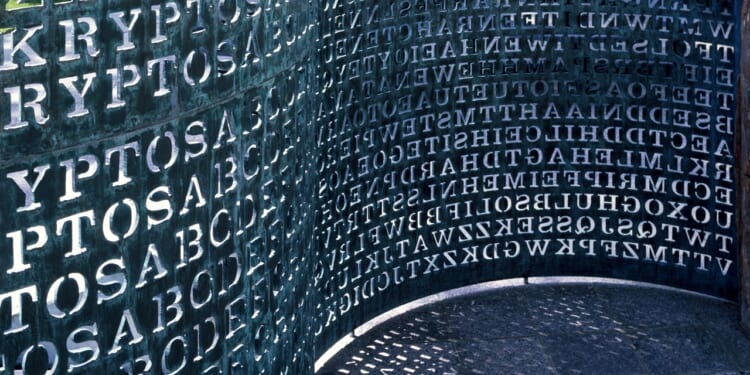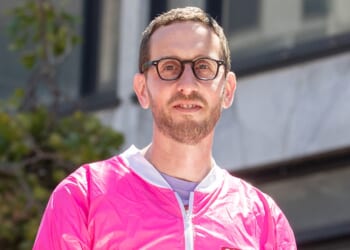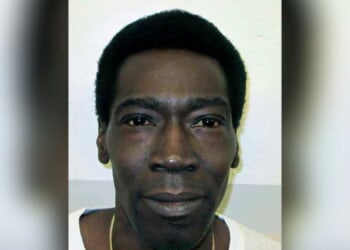The puzzle’s designer, James Sanborn, has urged the solution’s buyer not to reveal it, but to keep it safe until the Smithsonian releases its own copy.
Puzzlers, enigmatologists, and even professional cryptologists have yet to solve “K4,” the fourth and final encrypted puzzle on a sculpture on the grounds of the Central Intelligence Agency’s headquarters in Langley, Virginia.
The 10-foot-tall plate, one part of the “Kryptos” artwork created by artist James Sanborn, now sits in the courtyard of the New Headquarters Building at the George Bush Center for Intelligence. It serves to inspire, not just by evoking emotions and encouraging self-reflection, but literally by encouraging those who view it to uncover its hidden message.
The CIA Wants to Challenge Its Codebreakers
Installed in 1990, Kryptos was meant to challenge employees to break four encrypted messages.
As explained by the Associated Press, the “S-shaped copper screen” was meant to resemble “a piece of paper coming out of a fax machine,” while the CIA actually suggested it “looks like a piece of paper coming out of a computer printer.”
The sculpture contains four enigmatic messages, which the CIA explained were “each written in a different code,” described as being “important to the history of cryptography.”
The purpose wasn’t just to educate, but to entertain. Sanborn told the AP that he wanted to create something fun for those who worked at the CIA and regularly saw the piece.
“At the time, codes and encoding was an esoteric subject,” Sanborn said. “I wanted it to be less so, and I wanted it to be fun. … Any artist’s goal when they make an artwork is to have the viewer’s attention for as long as possible.”
Sanborn’s Puzzle Is Too Tough to Crack
Sanborn worked for four months with a retired CIA cryptographer to ensure that the first three encrypted messages, known as K1, K2, and K3, would be quickly broken. They were easy, relatively speaking.
The CIA acknowledged in 1998 that it had cracked the codes for three sections. The solution to K1 and K2 involved using a Vigenère cipher, developed by the cryptographer Blaise de Vigenère.
K3 employed transposition, paraphrasing the quotation from British archaeologist and Egyptologist Howard Carter on the opening of the tomb of Tutankhamen.
The fourth section, K4, was also designed to be far more challenging. Sanborn perhaps succeeded better than he had hoped; it has been more than 35 years, and so far, no one has solved it.
It isn’t known how many CIA employees have attempted to break the code over the years, or how much effort has actually been invested in it. American taxpayers may not want to learn if the CIA and the NSA had devoted government time and resources to cracking the puzzle, rather than pursuing their other vital work.
Although it may not have been by design, Sanborn has made some money from making it especially hard. As AP reported, the artist “received so many inquiries that he began charging $50 per submission to make it more manageable.”
The Puzzle Has Stumped AI, Too… So Far
The puzzle has beaten the best minds so far. Interestingly, it has also been too complex for artificial intelligence (AI)—but not for lack of trying.
Professional cryptologists have reportedly utilized advanced analytical tools, and there have been claims on Reddit and other social networking groups that modern AI, including ChatGPT, has been successful in cracking the code. However, Sanborn has yet to confirm whether it has been solved.
The artist has provided some clues in the past. That included a 1986 trip he took to Egypt, as well as the 1989 fall of the Berlin Wall, which could be critical to the solution, as Sanborn had previously indicated “BERLINCLOCK” in K4 clues he released.
Moreover, despite some speculation that the puzzle can’t be solved, a solution is known to exist.
Reporters Jarett Kobek and Richard Byrne didn’t solve the puzzle by decoding it from the ciphertext; instead, they found the answer hidden in the archives of the Smithsonian Institution. Sanborn has confirmed the authenticity of the document and acknowledged that it was mistakenly included in the documents he provided to the institution. The Smithsonian and the reporters have agreed to seal the files for at least 50 years.
Sanborn’s Solution Will Now Be Auctioned Off
Sanborn is now 79, and as he has dealt with health issues, he announced earlier this year that he will auction off the solution to the code. He has said that he hopes the solution will not be disclosed by the prospective buyer, but instead will be hidden to allow the puzzle to continue—at least until someone is able to solve it via a ciphertext, or until the Smithsonian releases its answer.
“It’s sort of my last chance to impart information about what the new owner—or, as I call it, the Kryptos keeper—is going to be able to say and do after it’s transferred,” Sanborn explained to Scientific American.
Yet even when (or perhaps “if” is the better word) K4 is solved, there could be a K5 coded message that will become visible in the public space. It could include elements of the other puzzles.
The auction for the solution runs through November 20.
“Since its installation in 1990, Kryptos has become a worldwide phenomenon,” Bobby Livingston, executive vice president at RR Auction, told AP. “K4 has stumped professional cryptologists and code breakers as well as amateurs who have tried to solve it and read the message. The winner of this archive is now going to possess the secrets of Kryptos.”
Winston Churchill once described the Soviet Union’s actions in 1939 as being “a riddle wrapped in a mystery inside an enigma.” The Kryptos sculpture is a puzzle coded in encryption, and it remains a mystery.
About the Author: Peter Suciu
Peter Suciu has contributed over 3,200 published pieces to more than four dozen magazines and websites over a 30-year career in journalism. He regularly writes about military hardware, firearms history, cybersecurity, politics, and international affairs. Peter is also a contributing writer for Forbes and Clearance Jobs. He is based in Michigan. You can follow him on Twitter: @PeterSuciu. You can email the author: [email protected].
Image: Wikimedia Commons.

















